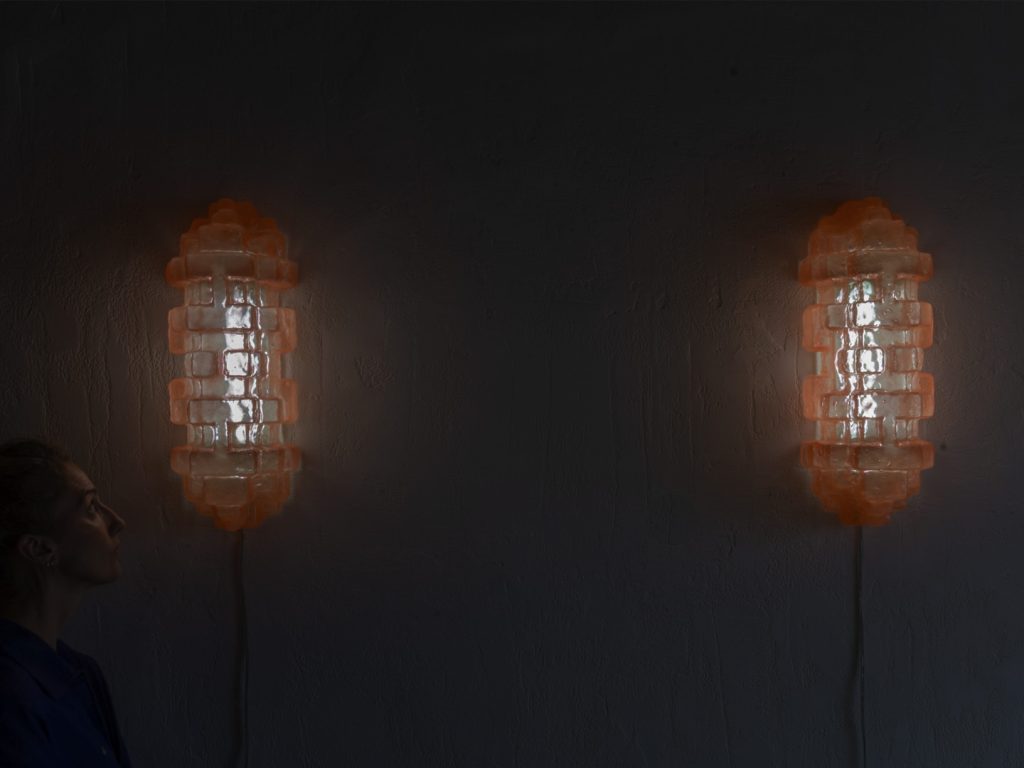Ibérica corpus
The works in the Ibérica series are illuminated structures that act as fragments of an ancestral language, vestiges of an uncertain time that quietly emerge into space. More than sources of light, they rise as symbolic thresholds between the visible and the hidden, the material and the intangible. Their surfaces suggest futuristic ruins where geometry and organicity intertwine in silent balance, projecting an energy that oscillates between the ritual and the cybernetic, between twilight and radiance.

Light projection through cubic ethereal bodies, floating in the space. An illusion of suspended basaltic crystal rocks. Volatility, evanescence, parallel dimension.
Light goes through volumes and texture generated by epoxy resin and fiberglass, scattering in all directions, creating an emotive illusion of gradient light, shadows and color, emphasizing the feeling of unreality and dreaminess.
The lighting is warm, full of matches, unique and personal.
This work is a point of union between sumptuousness and magic; a representation of an invented hieroglyphic language that traces lost connections with the sacred texts of extinct civilizations. Ibérica gathers a multitude of imaginary references to its geographical and cultural environment, rearticulating and projecting them from our contemporary vision. It is a sculptural work with a distinctly ceremonial character.
The technical gesture reinforces this dimension: each piece is hand-modeled in epoxy resin using the lost mold technique. The manual trace and the deliberate irregularity of its contours and transparencies become a material testimony, transforming imperfection into character and the artisanal process into projected energy.
The piece has a tubular structure with extruded reliefs reminiscent of Andalusí Kufic script, an icon of the city of Seville. When pierced by light, it projects a play of watery reverberations around it, creating a dreamlike, mystical atmosphere and an intense sensation of unreality.
Within its volumes also lies the memory of vernacular and ceremonial architecture: the red clay bricks from the potteries of Triana, with which buildings in Seville were erected and later reinterpreted during the Neo-Mudéjar tradition of the early 20th century. In this way, the local and the archaic merge with the visionary in a contemporary object that functions as both symbolic portal and sensory experience.
Pieces created one to one using a unique manual process and by lost mold.
8 units + 1 AP by model.
IBÉRICA P: yellow solid epoxi resin. Dimensions: 180 x 20 x 20 cm.
IBÉRICA Y: green solid epoxi resin. Dimensions: 180 x 20 x 20 cm.
IBERICA W: pink solid epoxi resin. Dimensions: 54 x 39,5 x 39,5 cm.
IBERICA WS: pink solid epoxi resin. Dimensions: 54 x 39,5 x 39,5 cm.
Analogic glitches beyond the Ciberculture Matrix
We developed these pieces after discovering a new working method with epoxy resin. We were looking for a material that we could use and apply with our own hands, generating manual textures similar to clay works, but that would allow light to pass through and we decided to investigate with epoxy resin.
We knew some of its applications, mainly in the wáter sports industry, and a surfboards shapers how edushow to Work with the material, the translucency we could achieve, the resistance… We did tests for about a year. At first we introduced fiberglass and we tried other techniques, such as silicone molding, sandblasting… studying the material, its resistance, temperatura and humidity for better application and Chemical reaction.
Finally we found a way to work the material with our hands. For the master mold we needed a material that we could later extract so we arrived at EPS which, treated previously, allowed us to reproduce the shape and, after applying resin, to destroy it and detach from the final work.
Each of the Works is unique. Both in the color, which is slightly variable in the resin due to issues such as temperature and humidity, and in the arrangement of the airbubbles that are trapped randomly, creating a piece with a watery and some what spectral appearance.
These Works have been acquired by private collectors all over the world and have appeared in media such as TMagazine, AD or ICONDesign to name a few.